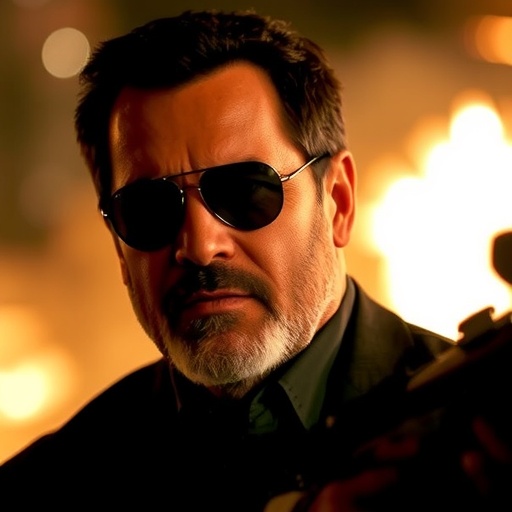Michael Mann’s ‘Heat 2‘ Lands $37.2 Million California Tax Incentives for Epic LA Shoot
In a major win for Hollywood’s comeback story, director Michael Mann’s highly anticipated sequel Heat 2 has secured a whopping $37.2 million in California tax incentives, paving the way for principal photography in the heart of Los Angeles. This funding, drawn from the state’s robust $750 million annual film and TV production program, not only reignites the iconic crime thriller franchise but also promises a significant economic jolt to California’s beleaguered entertainment industry.
- Unlocking the $37.2 Million Windfall: How Heat 2 Qualified for California’s Top-Tier Incentives
- Michael Mann’s Masterclass: Crafting Heat 2’s High-Stakes Sequel in LA’s Shadowy Streets
- California Tax Incentives Revolution: Heat 2 Joins a Wave of Hollywood Homecomings
- Economic Powerhouse Unleashed: Heat 2’s $37.2 Million Injection Sparks LA Job Boom
- Revving Up for Release: Heat 2’s Timeline, Casting Buzz, and Global Fan Frenzy
The announcement, made by the California Film Commission on Thursday, underscores the state’s aggressive push to lure big-budget projects back from international locales like Georgia and Canada, where tax breaks have long overshadowed Hollywood’s traditional allure. For fans of the 1995 classic Heat, starring Al Pacino and Robert De Niro in their legendary cat-and-mouse showdown, this development signals that the long-gestating Heat 2 is finally charging toward production, with Mann at the helm to deliver another pulse-pounding narrative based on the novel co-authored by himself and Meg Gardiner.
California’s tax incentives, a lifeline for local crews and studios, come at a critical time. The program, expanded in 2020 to $750 million amid the COVID-19 pandemic’s devastation on film jobs, has already approved over $1 billion in credits since its inception. Heat 2‘s allocation represents one of the largest single-project awards, highlighting the sequel’s scale and Mann’s enduring clout in Tinseltown.
Unlocking the $37.2 Million Windfall: How Heat 2 Qualified for California’s Top-Tier Incentives
The path to securing these California tax incentives wasn’t a straight shoot for Heat 2. Michael Mann’s project, which Warner Bros. has been developing since acquiring the rights to the 2022 novel, underwent rigorous evaluation by the California Film Commission. To qualify, productions must demonstrate a minimum in-state spend—typically 25% of the total budget for feature films—and commit to filming at least half of principal photography in California. For Heat 2, estimated to have a budget north of $150 million, the incentives cover up to 25% of qualified expenditures, translating to that eye-popping $37.2 million figure.
Commission officials revealed that Heat 2 impressed with its detailed proposal, emphasizing Los Angeles as the narrative’s soul. The original Heat was a love letter to LA’s underbelly—neon-lit freeways, shadowy downtown skyscrapers, and the sprawling urban maze that amplified the tension between Pacino’s relentless cop and De Niro’s meticulous thief. Mann, known for his meticulous location scouting, plans to recapture that authenticity, filming in iconic spots like the Bradbury Building and the Los Angeles River, which could only be achieved with substantial local investment.
“This isn’t just about tax breaks; it’s about preserving the magic of Hollywood storytelling on home turf,” said Amy Lemisch, Executive Director of the California Film Commission, in a statement. “Heat 2 will inject millions into our economy while showcasing California’s unparalleled locations to the world.” The incentives are non-refundable tax credits, meaning Warner Bros. can offset future state taxes or sell them to other entities, a mechanism that’s funded over 1,200 productions and created 200,000 jobs since 2009.
Delving deeper, the allocation process involves a competitive lottery for projects exceeding certain thresholds. Heat 2 edged out competitors by scoring high on diversity hiring commitments and sustainable production practices—key criteria in the program’s modern iteration. Mann’s team pledged to employ at least 40% local crew from underrepresented communities, aligning with California’s equity goals. This strategic alignment not only boosted the application’s viability but also positions Heat 2 as a model for future incentive recipients.
Historically, California’s program has evolved from a modest $10 million pilot in 2009 to its current powerhouse status. Early skeptics questioned its ROI, but data from the California Film Commission shows a multiplier effect: every dollar in incentives generates $7.65 in economic activity. For Heat 2, that could mean upwards of $284 million in total impact, including direct spending on catering, equipment rentals, and post-production services in LA studios like Warner Bros.’ Burbank lot.
Michael Mann’s Masterclass: Crafting Heat 2’s High-Stakes Sequel in LA’s Shadowy Streets
Michael Mann, the 81-year-old auteur behind cinematic benchmarks like The Insider, Collateral, and the original Heat, brings a lifetime of precision to Heat 2. The sequel expands the timeline, flashing back to the 1980s heists of De Niro’s Neil McCauley and forward to the post-climactic fallout for Pacino’s Vincent Hanna, weaving in new characters and escalating threats. Mann’s insistence on filming in Los Angeles isn’t mere nostalgia; it’s integral to the film’s DNA.
“LA is the character,” Mann told Variety in a recent interview, echoing sentiments from the ’90s production. “The city’s rhythm—the traffic, the heat waves, the isolation amid millions—fuels the story’s intensity.” Securing California tax incentives allows Mann to avoid the green-screen pitfalls that plagued some out-of-state shoots, ensuring Heat 2 retains the gritty realism that defined its predecessor. Practical effects, like choreographed bank heists and high-speed pursuits on the 405 Freeway, demand LA’s infrastructure, from closing streets to coordinating with LAPD for authenticity.
The novel, which Mann co-wrote with Gardiner, provides a rich blueprint, but the director’s vision elevates it. Casting rumors swirl around Adam Driver as a young McCauley and potentially Austin Butler stepping into Hanna’s shoes, though Mann has remained tight-lipped. What is clear: Heat 2 will honor the original’s technical wizardry, with cinematographer Hoyte van Hoytema (of Oppenheimer fame) rumored to lens the project, capturing LA at dawn and dusk for that signature Mann glow.
Mann’s track record with California tax incentives dates back; he utilized similar breaks for Blackhat in 2015, though that film’s global shoot diluted the local focus. Learning from that, Heat 2 commits to 85% California-based filming, a boon for VFX houses in the state handling the sequel’s explosive action sequences. Industry insiders praise Mann’s adaptability: at an age when many directors retire, he’s leveraging these incentives to mount a passion project that could redefine late-career triumphs.
Moreover, Heat 2‘s development saga adds intrigue. Announced in 2019, the project faced delays from the pandemic and script refinements, but the tax credit approval accelerates pre-production. Mann’s hands-on approach—storyboarding every frame—means crews can expect a demanding yet rewarding shoot, much like the original’s 108-day marathon that birthed one of cinema’s most quoted scenes: the coffee shop détente between Pacino and De Niro.
California Tax Incentives Revolution: Heat 2 Joins a Wave of Hollywood Homecomings
California’s tax incentives program has become the golden ticket for projects like Heat 2, reversing the exodus of film jobs that saw LA’s share of U.S. production plummet to 20% by 2018. The $750 million annual cap, funded by state general funds, allocates 35% to independent films and the rest to tentpoles, with Heat 2 falling squarely in the latter. Since the 2020 expansion, approvals have surged 40%, attracting behemoths like Amazon’s The Lord of the Rings: The Rings of Power and Netflix’s The Gray Man, both of which filmed extensively in the state.
For Heat 2, the incentives mitigate rising costs—LA permits alone can exceed $1 million for a major action film—while fostering ancillary benefits. Hotels in downtown LA anticipate bookings for the cast and crew, and local vendors from prop masters to stunt coordinators stand to gain. A 2023 study by the Milken Institute pegged the program’s total economic contribution at $26 billion over a decade, with Heat 2‘s slice promising to sustain that momentum.
Critics of the program argue it subsidizes profitable studios, but proponents counter with hard numbers: 85% of incentivized projects spend over their qualified budgets in California, creating ripple effects in tourism and real estate. Governor Gavin Newsom, a vocal supporter, highlighted Heat 2 in a tweet: “Bringing Michael Mann’s masterpiece sequel home isn’t just good for movies—it’s great for jobs and our economy.” This aligns with broader efforts, like the state’s $30 million soundstage grants, positioning California as a resilient film hub post-strikes.
Comparatively, Georgia’s 30% credits lured Heat 2‘s initial scouting, but LA’s cultural cachet won out. Other states like New York offer up to 40%, yet none match California’s blend of incentives and infrastructure. For Mann, it’s a full-circle moment: the original Heat grossed $187 million worldwide without such aid, but today’s blockbuster economics demand it. As Heat 2 joins approved projects like Mickey 17 by Bong Joon-ho, the program solidifies its role in Hollywood’s revival.
The incentives also emphasize ESG (Environmental, Social, Governance) factors. Heat 2‘s pledge includes electric vehicle fleets for transport and zero-waste catering, earning bonus points in the application. This forward-thinking approach not only secures funding but appeals to eco-conscious audiences, potentially boosting the film’s marketability.
Economic Powerhouse Unleashed: Heat 2’s $37.2 Million Injection Sparks LA Job Boom
Beyond the glamour, Heat 2‘s California tax incentives are a economic engine for Los Angeles. Projections from the Film Commission estimate the production will create 2,500 direct jobs—grips, electricians, makeup artists—and 5,000 indirect ones in supporting industries. With an in-state spend exceeding $148 million (before credits), the ripple could add $1.1 billion to California’s GDP, per econometric models used by state analysts.
LA’s film sector, which employs 700,000 statewide, has rebounded from pandemic lows, but challenges persist: rising living costs and competition from virtual production tech. Heat 2 addresses this by prioritizing union labor, aligning with the 2023 WGA and SAG-AFTRA strikes’ resolutions for fair wages. Local IATSE chapter president Steve Marder noted, “Projects like Heat 2 keep families fed and skills sharp—tax incentives are our best defense against offshoring.”
Breaking it down: $15 million of the incentives will fund below-the-line crew salaries, $10 million for location fees and permits, and the rest for post-production at facilities like Company 3 in Hollywood. This sustains a ecosystem strained by the 2023 strikes, which idled 45,000 jobs. Tourism benefits too—fans pilgrimaging to Heat sites like Union Station could double with the sequel, injecting $50 million annually into visitor spending.
Broader impacts include workforce development: Heat 2 commits to apprenticeships for 200 entry-level positions, targeting diverse talent pools in South LA and the Valley. Data from similar projects, like Top Gun: Maverick, shows incentives yield a 9:1 return on investment, with Heat 2 poised to exceed that through its global appeal. Warner Bros., fresh off Dune‘s success, views the credits as a strategic hedge against inflation, ensuring fiscal viability for Mann’s ambitious vision.
Challenges remain: bureaucracy can delay reimbursements, and environmental regs for filming in sensitive areas like the Hollywood Hills require navigation. Yet, the net positive is undeniable—Heat 2 exemplifies how targeted incentives rebuild Hollywood’s backbone, one blockbuster at a time.
Revving Up for Release: Heat 2’s Timeline, Casting Buzz, and Global Fan Frenzy
With California tax incentives locked in, Heat 2 shifts into high gear, targeting a late 2025 production start and a 2027 theatrical debut. Pre-production ramps up in Q1 2025, with Mann overseeing script finalizations and casting calls. While De Niro and Pacino’s involvement is unconfirmed—both in their late 70s/80s—the project eyes legacy cameos alongside fresh faces, fueling speculation that could drive box office pre-sales.
Fan excitement is palpable: online petitions for the sequel garnered 500,000 signatures, and Heat‘s recent 4K re-release topped $10 million domestically. Heat 2 promises to expand the lore, exploring McCauley’s armored truck heists and Hanna’s unraveling psyche, with Mann teasing IMAX sequences for immersive action. Marketing tie-ins, from novel merchandise to LA tourism campaigns, will leverage the incentives’ local focus.
Looking ahead, success could inspire more Mann projects, like a Thief remake, while bolstering California’s program—potentially upping the cap to $1 billion by 2026. For the industry, Heat 2 signals optimism: a blend of nostalgia, innovation, and economic savvy that keeps Hollywood burning bright.










